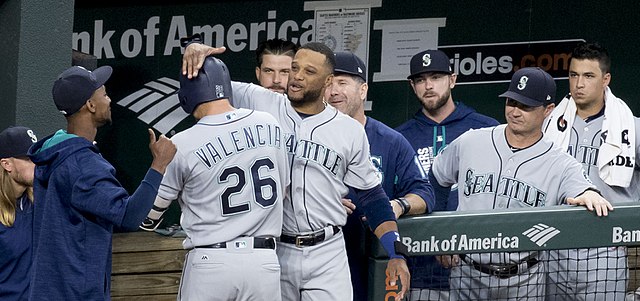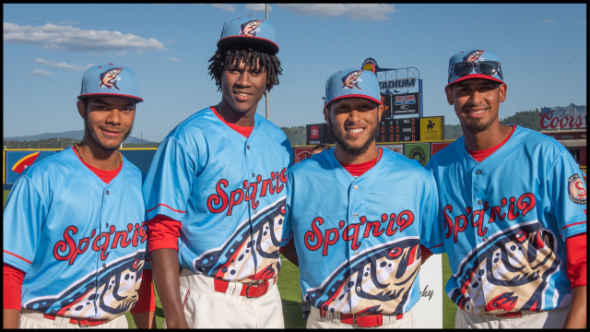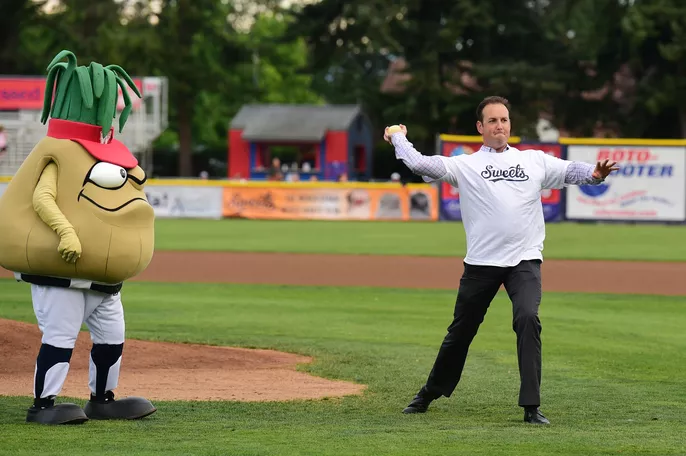
Editor’s note: Interested in experiencing baseball in Washington state? Check out our Washington State Baseball Tour. You can combine it with the legendary Alaskan Midnight Sun Game to experience the full Pacific Northwest Baseball Tour! Also, see Part 2 of this “Pacific Pastime” series – Baseball in Oregon, Vancouver, & Alaska.
While it may be known as America’s pastime, baseball history in the States is perhaps most commonly associated with the Midwest and East Coast. The first professional baseball team was the Cincinnati Red Stockings, and Major League Baseball’s stalwart early franchises were located in cities like New York, Boston, and Philadelphia. In fact, MLB did not reach the Pacific Time Zone until 1958, with the San Francisco Giants and Los Angeles Dodgers arriving that year. Even at the minor league and independent level, the more famous teams and legends seem to reside east of the Mississippi River, with entities like the Cape Cod Baseball League and Durham Bulls being the most popular.
And yet, the romantic aspect of baseball that truly makes it America’s pastime – the stadium lights against a pink sunset, the smell of pure, cool fresh air, a rich history that loves small-town success – is perhaps no better represented than in the Pacific Northwest. Plenty has been said about MLB’s Seattle Mariners and their star-studded, yet complicated history as the ultimate underdog, but there’s much more baseball lore in the region than you may suspect.
For example, did you know Washington has been home to professional baseball since the 1800s? Or that they play host to their own version of the Cape Cod League, featuring some of the best collegiate players looking for quality summer competition? Did you know that one of the greatest and most challenging tragedies in the history of the sport occurred in Washington, and how the team bounced back to become one of the most storied franchises in the history of minor league ball?
Regardless if you knew or not, there is plenty of love and baseball history on both sides of the Cascades in Washington, in both the professional and amateur leagues. So grab your hiking boots and keep your eyes peeled for an Olympic marmot or a sweeping view of Mount Rainier, because we’re going to the Evergreen State to experience a new love of the game.
Mariners and More

When most think of Washington state, they first think of Seattle, and for good reason. One of the most picturesque and unique cities in the world, Seattle is known for its green and gray backdrop and the colorful individuals that inhabit it, a cloudy hotbed of creativity and unique spirit.
The Seattle Mariners represent this description perfectly, as their green and gray (and teal) uniforms have been donned by some of the greatest players in MLB history: “The Kid” (Ken Griffey, Jr.), “The Big Unit” (Randy Johnson), A-Rod (Alex Rodriguez), “King Felix” Hernandez, and Ichiro Suzuki being just a few examples. While the historical identity of the team has been that of an underdog or underachiever – they’ve only seen five playoff appearances in their 45-year history – the recent success of the team has made them media darlings, as they clinched their first playoff appearance in 21 years this past season in typical storybook fashion.
The Mariners’ historical lack of team success is well-documented, but their 1995 Cinderella run earned them two things: respect, and a new stadium. T-Mobile Park is one of the most beautiful places in MLB to catch a game, often breaking into the top 10 of ballpark rankings for its outstanding sightlines and food and beverage service, which includes unique Asian cuisine like sushi, pad thai, and dumplings, as well as the infamous chapulines (Mexican deep fried grasshoppers).
The stadium demonstrates the local pride in its region’s rich baseball history, hosting the Baseball Museum of the Pacific Northwest and featuring artifacts from professional clubs from Washington, Oregon, Idaho, Montana, and British Columbia that inhabited the region before the Mariners.
Speaking of those other teams… the Mariners may be the most famous example of baseball in Seattle, but they’re not the only team to ever occupy the area, as the city has hosted a wide variety of teams that can only be described as the stuff of campfire stories.
The Seattle Pilots, for example, were the ill-fated first attempt at Major League Baseball in Washington, and only saw one season in the area before packing up for Milwaukee; their sudden departure triggered a lawsuit from Seattle’s government, which was only resolved with the introduction of the Mariners a few years later. On the other side of the coin are the Seattle Turks, who also only played one season but saw a much different ending, winning a Northwestern League pennant in 1909. The Mariners ensure that the team is remembered even over a century later, celebrating their legacy with throwback uniforms in special games.
Tacoma: Seattle’s Sibling has its own Shine
About 40 minutes south of Seattle lies the beautiful city of Tacoma. Backdropped by Mount Rainier, Tacoma is a more industrialized area, with its origins rooted in being the land transport terminus for the North Pacific Railroad and those wishing to reach the Seattle seaport, with its official motto being, “When rails meet sails.”
There is perhaps no better metaphor for Tacoma baseball than its minor league team, the aptly named Tacoma Rainiers. The Rainiers have a rich history of baseball in the region, having begun play in 1960 and serving as the Triple-A team for seven MLB teams. Serving as the official AAA farm team of the Mariners since 1995, the squad – like Tacoma to Seattle – helps feed the more well-known team, with stars like Hernandez, Griffey, Rodriguez, and fan-favorite Jay Buhner all donning the Rainiers logo at some point in their careers.
Beyond the star power, Cheney Stadium is one of the most beautiful stadiums in the minor leagues, touting an unbeatable backdrop of spruce forests and majestic Mt. Rainier, and oblong dimensions seemingly reminiscent of the old Polo Grounds (325 down the lines, 425 to dead center). The stadium went through a massive modernization effort in 2010 to keep guests coming for decades to come. The result was a refreshed ballpark that still maintains its vintage charm. A crown jewel of the Tacoma area, the park is enjoyed by hardcore and casual fans alike, with a kids’ play area, in-stadium restaurant, and over a dozen luxury suites.
Through the Mountains and to the Desert

While Washington is called the “Evergreen State,” the motto actually only represents half of the territory. The Cascade Mountains serve as a border between eastern and western Washington, with the latter enjoying the gray and cool climate the state is known for. To the East, however, it’s much different: an arid desert filled with sand and plains.
To first get to the desert, however, one must first pass through the Cascades. While the tight curves and tunnels do offer a challenge, the views of the valleys below and endless pines make it one of the most beautiful road trips in the country. Even these winding roads have their share of baseball history in the region, serving as the backdrop for one of the worst tragedies in sports history.
On June 24, 1946, the Spokane Indians – one of the region’s oldest clubs, having a history dating back to 1892 – were on a road trip to Bremerton, Washington, passing through the Snoqualmie Pass on a late, rainy night. While hugging a tight turn, a car suddenly sped around the curve and looked to collide with the bus head-on; the team’s driver swerved to avoid the collision, only for the bus to break through the barrier and plunge nearly 500 feet into the valley below. Nine players were killed and seven injured in the accident, which to this day remains one of the worst transit accidents in the history of American sports.
The accident is just one chapter of Spokane’s long history, interwoven with baseball, as the Indians are one of the most storied franchises in the minor leagues. The High-A club, currently the affiliate of the Colorado Rockies, has been affiliated with nine MLB franchises, and was a stepping stone for several big league names. The 1970 team, which won 94 of 146 games, is perhaps one of the greatest teams in minor league history, featuring names like Bill Buckner, Steve Garvey, Davey Lopes and Bill Russell on the diamond, as well as Bobby Valentine – who was named league MVP with a .340 average and 80 RBI – and hall-of-famer Tommy Lasorda serving as the squad’s skipper.

While the Indians have been a staple of Spokane for over a century, they continue to change and adapt to the modern sports landscape, even setting an example for other big league clubs. In 2006, as the team began redesigning their logo and colors, they planned to avoid any reference to Native American history, in fear that they may offend the indigenous population. However, the Spokane Nation, being made aware of the process, contacted the team and asked to work with them, keeping the name and helping design new logos that respected the tribe’s heritage. In the process, a new secondary logo was created, written in Salish; the traditional language of the tribe. The partnership continues today, with regular meetings between club leadership and tribe leaders.
With a rich history and an excellent heritage, it only makes sense that the Indians should also have an amazing ballpark. Ranked No. 31 of Stadium Journey’s top 100 stadium experiences in the United States and Canada for 2017 – the second-highest of any minor league ballpark on the list – Avista is a 65-year-old-masterpiece of small-town ball, hosting 6,800 fans and featuring top-notch food and beverage options. The field is also open to changes every now and then; for example, in 2022, the team took inspiration from the nearby Eastern Washington University and painted their entire field red. The grass is always greener on the other side, as they say.
The Indians, however, are not the only Northwest League team in the state, as two others compete with Spokane. The Everett AquaSox, for example, feature one of the coolest names and logos in all of baseball, with a large tree frog named Webbly serving as their mascot. JapanBall’s founder, Bob Bavasi – who also founded the AquaSox – explained the process of creating the name and mascot to the the Baseball by Design podcast in October 2022.
The other squad is the Tri-City Dust Devils, representing Kennewick, Pasco, and Richland. Their mascot and colors, a navy and khaki cloud appropriately named “Dusty,” was inspired by the frequent mini tornadoes in the farmland region surrounding the area, with particular emphasis on the “khaki” hills and the “deep, dark blue” of the Columbia River.
While that may be it for Washington’s professional teams, there’s still one more league to discuss: the Pacific Northwest’s answer to the Cape Cod League, the West Coast League.
College Ball in the Washington Wilderness

Established in 2005, the West Coast League attracts hundreds of college players from all over the country every summer for the chance to develop and showcase their skills. While it doesn’t quite have the history of other collegiate leagues, the league has been quite successful in its infancy, already seeing several players break through into major league organizations.
Washington plays host to seven of the sixteen teams in the league, with Oregon, British Columbia, and Alberta fielding the other nine. Of these seven, notable mascots include the AppleSox of Wenatchee – who famously toss pairs of socks into the crowd once AppleSox pitchers notch five strikeouts – the Port Angeles Lefties, the Yakima Valley Pippins, and the Ridgefield Raptors.
The most notable of these clubs, however, is the Walla Walla Sweets, who joined the league for the 2010 season and immediately set a record for season attendance (40,461 in 28 games). The Sweets, named after the prodigiously-grown jumbo sweet onions from the farming region, really lean into the motif: instead of a baseball, they use an onion for the first pitch. Sweet Lou is the team’s mascot, and while he’s not as terrifying as other mascots, that scowl is enough to send opposing teams packing.
It’s small-town ball to perfection in the West Coast League. Most stadiums in the league seat no more than 4,000 fans, and each stadium has their own local flavor intertwined with gameday fun.
Big league, minor league, and collegiate league, the Pacific Northwest has it all… including some of the most unique stories in the sport today.
